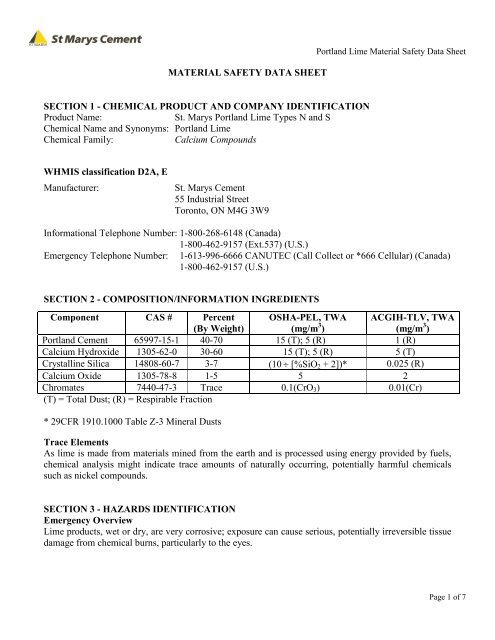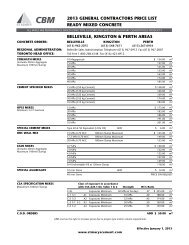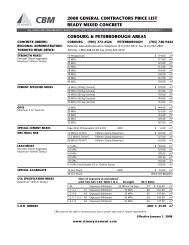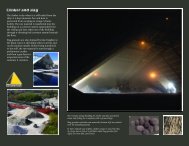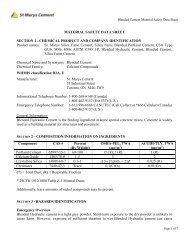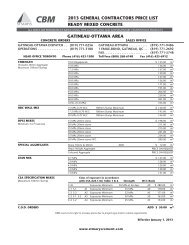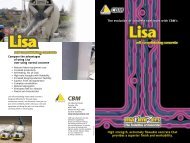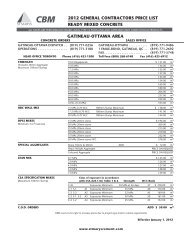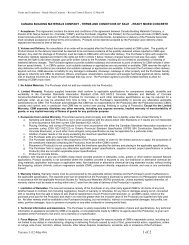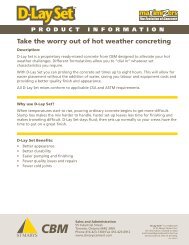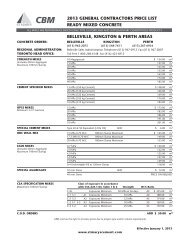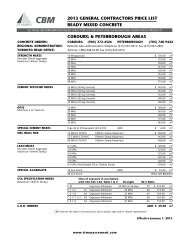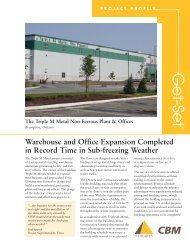Create successful ePaper yourself
Turn your PDF publications into a flip-book with our unique Google optimized e-Paper software.
<strong>Portland</strong> <strong>Lime</strong> Material Safety Data SheetEngulfment hazard<strong>Cement</strong> can build up or adhere to the walls of a confined space such as a silo, bin, bulk truck, or othercontainer or vessel. The material can be detached, collapse or fall unexpectedly. To prevent burial orsuffocation, do NOT enter a confined space without precautions appropriate to Confined Spaces.Potential Health EffectsRelevant routes of exposure: eye contact, skin contact, inhalation, and ingestion.Effects Resulting from Eye Contact:Exposure to airborne dust may cause immediate or delayed irritation or inflammation. Eye contact bylarger amounts of dry powder or splashes of wet masonry cement may cause effects ranging frommoderate eye irritation to chemical burns and blindness. Such exposures require immediate first aid (seeSection 4) and medical attention to prevent significant damage to the eye.Effects Resulting from Skin Contact:Discomfort or pain cannot be relied upon to alert a person to a hazardous skin exposure. Consequently,the only effective means of avoiding skin injury or illness involves minimizing skin contact, particularlycontact with wet lime. Exposed persons may not feel discomfort until hours after the exposure has endedand significant injury has occurred.Exposure to dry lime may cause drying of the skin with consequent mild irritation or more significanteffects attributable to aggravation of other conditions. Dry lime contacting wet skin or exposure to moistor wet masonry cement may cause more severe skin effects including thickening, cracking or fissuringof the skin.Prolonged exposure can cause severe skin damage in the form of (caustic) chemical burns. Some ultrasensitiveindividuals may exhibit an allergic response upon exposure to lime, possibly due to traceamounts of chromium (hexavalent chromium salts). The response may appear in a variety of formsranging from mild rash to severe skin ulcers. Persons already sensitized may react to their first contactwith the product. Other persons may first experience this effect only after years of contact with limeproducts.Effects Resulting from Inhalation:<strong>Lime</strong> contains significant amounts of free crystalline silica. Prolonged exposure to respirable freecrystalline silica may aggravate other lung conditions. It also may cause delayed lung injury includingsilicosis, a disabling and potentially fatal lung disease, and/or other diseases.Exposure to lime may cause irritation to the moist membranes of the nose, throat, and upper respiratorysystem. It may also leave unpleasant deposits in the nose.Effects Resulting from Ingestion:Ill effects are possible if accidentally consumed.Carcinogenic Potential: See Section 11.Medical conditions which may be aggravated by inhalation or dermal exposurePre-existing upper respiratory and lung diseases.Unusual (hyper) sensitivity to hexavalent chromium salts.Page 2 of 7
<strong>Portland</strong> <strong>Lime</strong> Material Safety Data SheetSECTION 4 - FIRST AIDEyes:Immediately flush eyes thoroughly with water. Continue flushing eyes for at least 15 minutes, includingunder lids, to remove all particles. Seek medical attention.Skin:Wash skin with cool water and mild soap or a detergent intended for use on skin. Seek medicaltreatment in all cases of prolonged skin exposure to lime.Inhalation of Airborne Dust:Remove to fresh air. Seek medical help if coughing and other symptoms do not subside. Inhalation ofgross amounts of lime requires immediate medical attention.Ingestion:Do not induce vomiting. If conscious, have the victim drink plenty of water and call a physicianimmediately.SECTION 5 - FIRE & EXPLOSION DATAFlash Point .................................................................NoneLower Explosive Limit ..............................................NoneUpper Explosive Limit ...............................................NoneAuto Ignition Temperature ........................................Not CombustibleExtinguishing Media ..................................................Not CombustibleSpecial Fire Fighting procedures ...............................NoneAlthough lime poses no fire-related hazards, a self-contained breathing apparatus isrecommended to limit exposure to combustion products when fighting any fire.Hazardous Combustion Products ...............................NoneUnusual Fire and Explosion Hazards .........................NoneSECTION 6 - ACCIDENTAL RELEASE MEASURESCollect dry material in a non-reactive container and minimize dust. Wear appropriate personal protectiveequipment as described in Section 8. Scrape up wet material and place in an appropriate container.Allow the material to dry before disposal. Do not attempt to wash lime down drains. Dispose of wastematerial according to local, state and federal regulations (see Section 13).SECTION 7 - HANDLING AND STORAGEKeep lime dry until used. Normal temperatures and pressures do not affect the material. Promptlyremove dusty clothing or that which is wet with lime and launder before reuse. Wash thoroughly afterexposure to dust or wet lime mixtures.<strong>St</strong>atic HazardProperly ground all pneumatic conveyance systems. The potential exists for static build-up and staticdischarge when moving cement powders through a plastic, nonconductive, or non-grounded pneumaticconveyance system. <strong>St</strong>atic discharge may result in damage to equipment and injury to workers.Page 3 of 7
<strong>Portland</strong> <strong>Lime</strong> Material Safety Data SheetSECTION 8 - EXPOSURE CONTROLS/PERSONAL PROTECTIONEye protectionWear ANSI- or CSA-approved safety glasses with side shields or goggles. In extremely dustyenvironments and unpredictable environments, wear unvented or indirectly vented goggles to avoid eyeirritation or injury. Contact lenses should not be worn. Provide emergency eyewash stations.Skin ProtectionPrevention is essential. Avoid contact with lime products. Provide emergency shower stations.Periodically wash affected areas with soap and water. Wash again at the end of the work. If irritationoccurs, immediately wash the affected area with soap and water. Clothing saturated with wet limeshould be removed and replaced with clean dry clothing.Where prolonged exposure to lime might occur, wear impervious e.g. cut/abrasion-resistant rubber(Heavyweight Nitrile coated Safety cuff) gloves. Where required, wear boots that are impervious towater to eliminate foot and ankle exposure.Do not rely on barrier creams in place of gloves.Respiratory ProtectionAvoid actions that cause dust to become airborne. Use local or general ventilation to control exposuresbelow applicable exposure limits.Use NIOSH-approved respirators (N95 rating or greater) if an exposure limit is exceeded, or when dustcauses discomfort or irritation.VentilationUse local exhaust, where practicable, or general dilution ventilation to control exposure withinapplicable limits.SECTION 9 - PHYSICAL AND CHEMICAL PROPERTIESAppearance ................................................................Grey or White PowderOdour .........................................................................No Distinct OdourPhysical <strong>St</strong>ate .............................................................SolidpH in Water (ASTM D 1293-95) ...............................12 to 13Solubility in Water .....................................................Slightly Soluble (0.1 to 1.0%)Vapour Pressure .........................................................Not ApplicableVapour Density ..........................................................Not ApplicableBoiling Point ..............................................................Not Applicable (i.e., > 1000°C)Melting Point .............................................................Not ApplicableSpecific Gravity (H 2 O = 1.0) .....................................2.95Evaporation Rate ........................................................Not ApplicableSECTION 10 - STABILITY AND REACTIVITY<strong>St</strong>ability: <strong>St</strong>able, except in the presence of moisture. Contact with water will produce heat.Conditions to Avoid: Unintentional contact with water.Page 4 of 7
<strong>Portland</strong> <strong>Lime</strong> Material Safety Data SheetIncompatibility:<strong>Lime</strong> is strongly alkaline; it is incompatible with acids, ammonium salts and aluminum metal.Hazardous Decomposition: <strong>Lime</strong> will react slowly with atmospheric moisture and carbon dioxide toproduce heat, (caustic) calcium hydroxide and calcium carbonate.Hazardous Polymerization: Will not occur.SECTION 11 - TOXICOLOGICAL INFORMATIONCalcium oxide: Corrosive to living tissue.Calcium hydroxideEye: Severe irritant (eye-rbt 10mg SEV)Skin, mucous membrane, respiratory system: Irritant; causes dermatitisIngestion: Mildly toxic (orl-rat LD50: 7340 mg/kg)Crystalline silicaAcute Toxicity: Not acutely toxicChronic Toxicity: Respirable crystalline silica is the chief cause of pulmonary dust disease. Prolongedinhalation of crystalline silica can result in silicosis, a disabling pulmonary fibrosis characterized bygeneralized fibrotic changes, the development of miliary nodules in both lungs, and clinically by shortnessof breath on exertion, decreased chest expansion, lessened capacity for work, dry cough, absence of fever,increased susceptibility to tuberculosis, and characteristic x-ray findings of diffuse discrete nodulationscattered throughout both lung fields. In advanced stages, silicosis can include marked fatigue, extremedyspnea and cyanosis, loss of appetite, pleuritic pain and total incapacity to work. The disease can result indeath either from cardiac failure or from destruction of lung tissue, with resultant anoxemia.International Agency for Research on Cancer (IARC), The National Toxicology Program (NTP), orOccupational Safety and Health Administration (OSHA) do not specifically list lime as a carcinogen.Crystalline silica, a natural contaminant in lime, is classified as a carcinogen: IARC Group 1 “known tobe carcinogenic to humans”; ACGIH Group 2A “suspected human carcinogen” (limited evidence ofcarcinogenicity in humans and sufficient evidence in experimental animals with relevance to humans);NTP indicates that crystalline silica is reasonably anticipated to be a carcinogen (Group 2).Chromates and Nickel Compounds<strong>Cement</strong> products may contain trace amounts of hexavalent chromium and nickel compounds. Solublechromates in cement products have been stated to be the cause of cement dermatitis in some workers.Inorganic nickel compounds – pure or in trace amounts – are not absorbed through the skin in amountssufficient to cause systemic intoxication. However, their capability to cause contact dermatitis insensitized individuals is well known.SECTION 12 - ECOLOGICAL INFORMATIONEcotoxicity: No recognized unusual toxicity to plants or animals.Page 5 of 7
<strong>Portland</strong> <strong>Lime</strong> Material Safety Data SheetSECTION 13 - DISPOSALWaste material may be disposed to landfill after confirmation of suitability according to provincial (orlocal, state and federal regulations) through leachate testing. Uncontaminated material may be saved forfuture use. Dispose of bags in an approved landfill or incinerator.SECTION 14 - TRANSPORTATION DATAHazardous Material Description Proper Shipping Name:<strong>Lime</strong> is not hazardous under U.S. Department of Transportation (DOT) regulations or CanadianTransportation of Dangerous Goods (TDG) regulations, except for transport by aircraft.Hazard Class: Not applicable.Identification Number: Not applicable.Required Label Text: Not applicable.Hazardous Substances/Reportable Quantities: Not applicable.SECTION 15 - OTHER REGULATORY INFORMATION<strong>St</strong>atus under USDOL-OSHA Hazard Communication Rule, 29 CFR 1910.1200:<strong>Lime</strong> is considered a hazardous chemical under this regulation, and must be part of the hazardcommunication program.<strong>St</strong>atus under CERCLA/Superfund, 40 CRF 117 and 302: Not listed.Hazard Category under SARA (Title III), Section 311 and 312:<strong>Lime</strong> qualifies as hazardous substance with delayed health effects.<strong>St</strong>atus under SARA (Title III), Section 313:Not subject to reporting requirements under Section 313.<strong>St</strong>atus under TSCA (as of May 1997):Some substances in lime are on the TSCA inventory list.<strong>St</strong>atus under the Federal Hazardous Substances Act:<strong>Lime</strong> is a hazardous substance subject to statutes promulgated under the subject act.<strong>St</strong>atus under California Proposition 65:<strong>Lime</strong> products contains chemicals (trace metals) known to the <strong>St</strong>ate of California to cause cancer, birthdefects or other reproductive harm. California law requires the manufacturer to give the above warningin the absence of definitive testing to prove that the defined risks do not exist.<strong>St</strong>atus under the Canadian Environmental Protection Act: Not listed<strong>St</strong>atus under the Canadian Workplace Hazardous Materials Information System (WHMIS):<strong>Lime</strong> is considered to be a hazardous material under the Hazardous Products Act as defined by theControlled Products Regulations (CPR). This product has been classified in accordance with the hazardcriteria of the CPR and the <strong>MSDS</strong> contains all the information required by the CPR.Page 6 of 7
<strong>Portland</strong> <strong>Lime</strong> Material Safety Data SheetSection 16 - OTHER INFORMATIONRevision date: September 2013; Prepared by: IHEAS Inc. (Tel. 519-657-5105)Date of previous <strong>MSDS</strong>: September 2010<strong>Portland</strong> <strong>Lime</strong> should only be used by trained, knowledgeable persons. This material safety data sheet isbelieved to provide a useful summary of the hazards of <strong>Portland</strong> lime as it is commonly used, but cannotanticipate and provide all of the information that might be needed in every situation.In particular, the data furnished in this sheet do not address hazards that may be posed by other materialsmixed with <strong>Portland</strong> <strong>Lime</strong> products.SELLER MAKES NO WARRANTY, EXPRESSED OR IMPLIED, CONCERNING THE PRODUCT OF THEMERCHANTABILITY OR FITNESS THEREOF FOR ANY PURPOSE OR CONCERNING THE ACCURACY OF ANYINFORMATION PROVIDED BY ST. MARYS CEMENT, EXCEPT THAT THE PRODUCT SHALL CONFORM TOCONTRACTED SPECIFICATIONS.The information provided herein was believed by <strong>St</strong>. <strong>Marys</strong> <strong>Cement</strong> to be accurate at the time ofpreparation or prepared from sources believed to be reliable, but it is the responsibility of the user toinvestigate and understand other pertinent sources of information to comply with all laws andprocedures applicable to the safe handling and use of product and to determine the suitability of theproduct for its intended use. Buyer’s exclusive remedy shall be for damages and no claim of any kind,whether as for product delivered or for non-delivery of product, and whether based on contract, breachof warranty, negligence, or otherwise, shall be greater in amount than the purchase price of the quantityof product in respect of which damages are claimed. In no event shall Seller be liable for incidental orconsequential damages, whether Buyer’s claim is based on contract, breach of warranty, negligence orotherwise.Page 7 of 7


